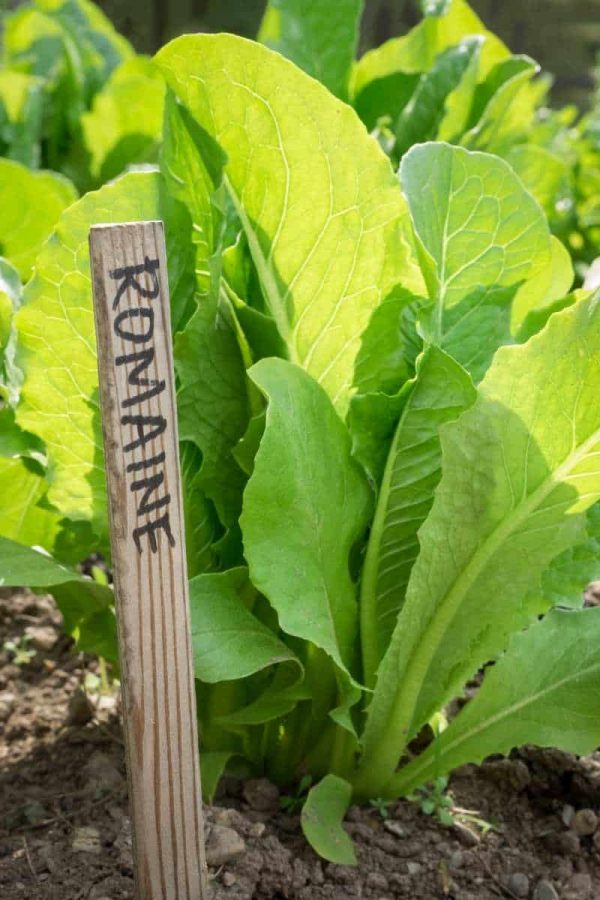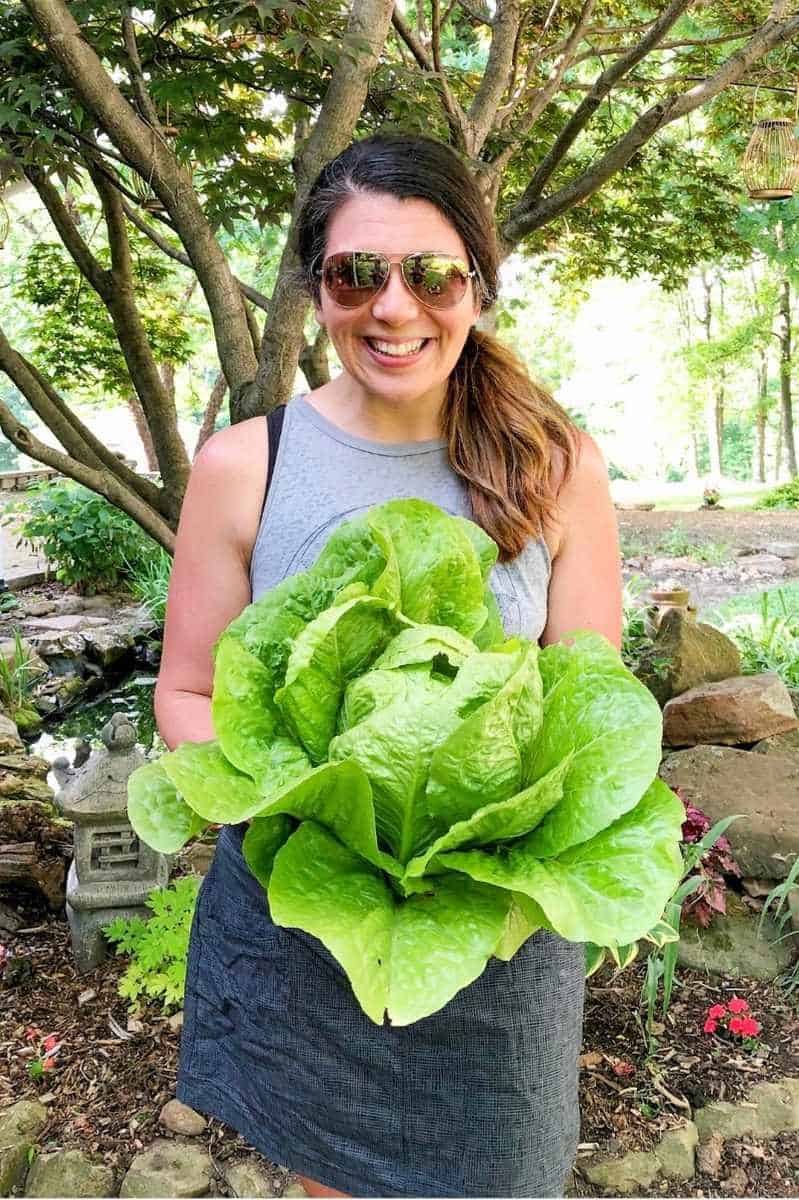You will always find romaine lettuce (aka: cos lettuce) in my garden. It’s easy to grow, stupendously crunchy, and super versatile in the kitchen. There are many types of lettuce you can grow—and we recommend you try out other leaf lettuces and head lettuces, too—but romaine is my favorite for its flavor, texture, and ease. There are literally hundreds of varieties of romaine in colors from bright lime green to so dark red it almost looks black.
We’re going to give you all the info you need to grow cos lettuce in your own garden at home—you are just a few weeks away from amazing Caesar salads! Let’s get growing.
Table of Contents
Is romaine lettuce easy to grow?
Definitely. Whenever we get asked about good vegetables for beginners to grow, lettuce and radishes are at the top of our list. It isn’t particularly fussy and it grows quickly, so you can enjoy some bounty from the garden relatively early. In particular, we think romaine is the easiest of all lettuces to grow!
Can romaine lettuce grow in shade?
Leafy greens such as lettuce are the most tolerant of shade, but the plants still need at least 4 to 6 hours of direct sun a day. If you don’t have a full sun spot for lettuce, you can plant it where the romaine will get morning sun and light afternoon shade. In fact, all lettuces will appreciate a little afternoon shade—especially during the hotter parts of the year.
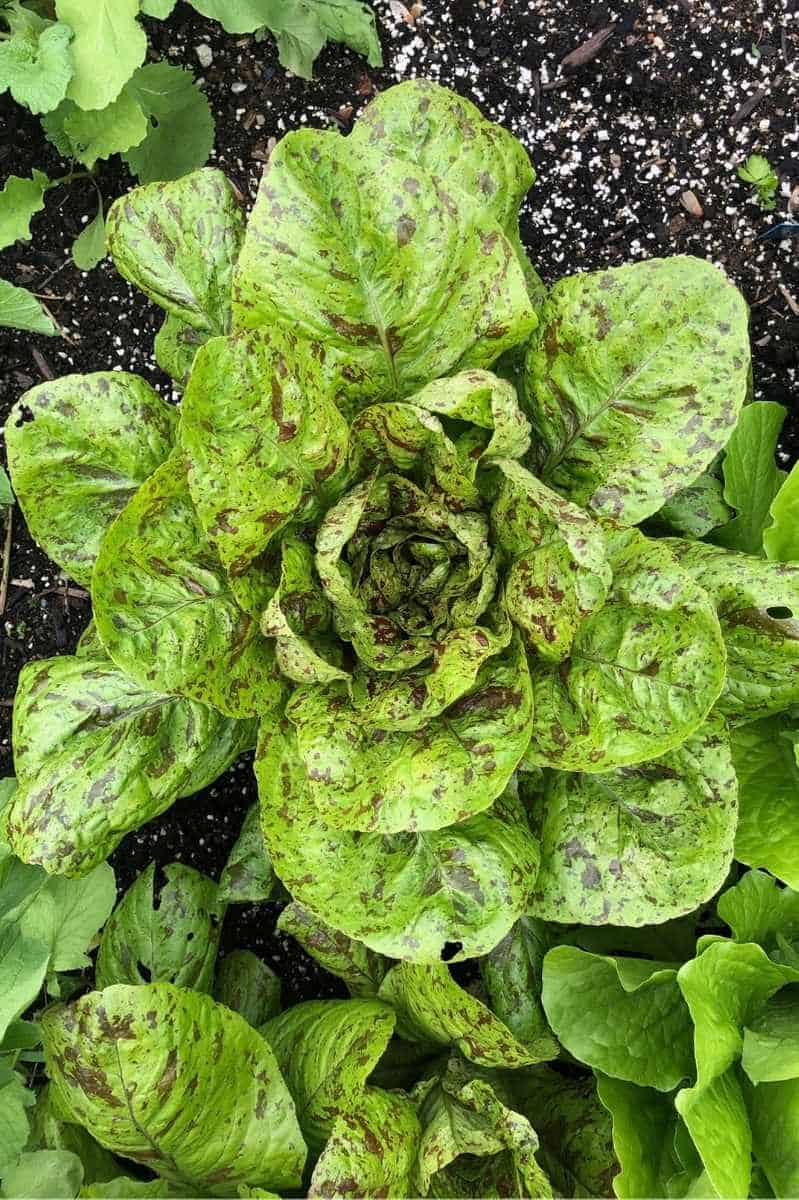
Are there different varieties of romaine lettuce?
There are two main types of lettuce: heading lettuces and looseleaf lettuce. Romaine is a type of heading lettuce with upright, more elongated leaves. But romaine isn’t just one kind of lettuce—there are lots of romaine lettuce varieties! These are some of our favorites:
- Valmaine is a more heat-tolerant romaine lettuce variety. It is bright lime green and produces huge heads that will make a big enough Caesar salad to feed an entire family! It is a favorite in the Growfully gardens! We have grown it for well over a decade.
- Flashy Trout’s Back is a green and red speckled lettuce (see the photo above) that looks beautiful in a salad bowl. It has a slightly more open head, but still has the crisp leaves you expect from cos lettuce.
- Truchas has beautiful ombre leaves that go from deep, dark burgundy at the tips to bright lime green at the core. It is truly one of the most beautiful lettuces we’ve ever grown. Truchas produces mini heads—which are perfect for single folks or small families.
- Little Gem is a dwarf variety with green leaves that is great for tight spaces.
- Cimmaron has dark red-purple leaves and a green heart. Like Valmaine, it is slower to bolt than most romaine varieties.
- Winter Density is a more cold-tolerant variety, making it a good choice for northern climates with chillier springs.
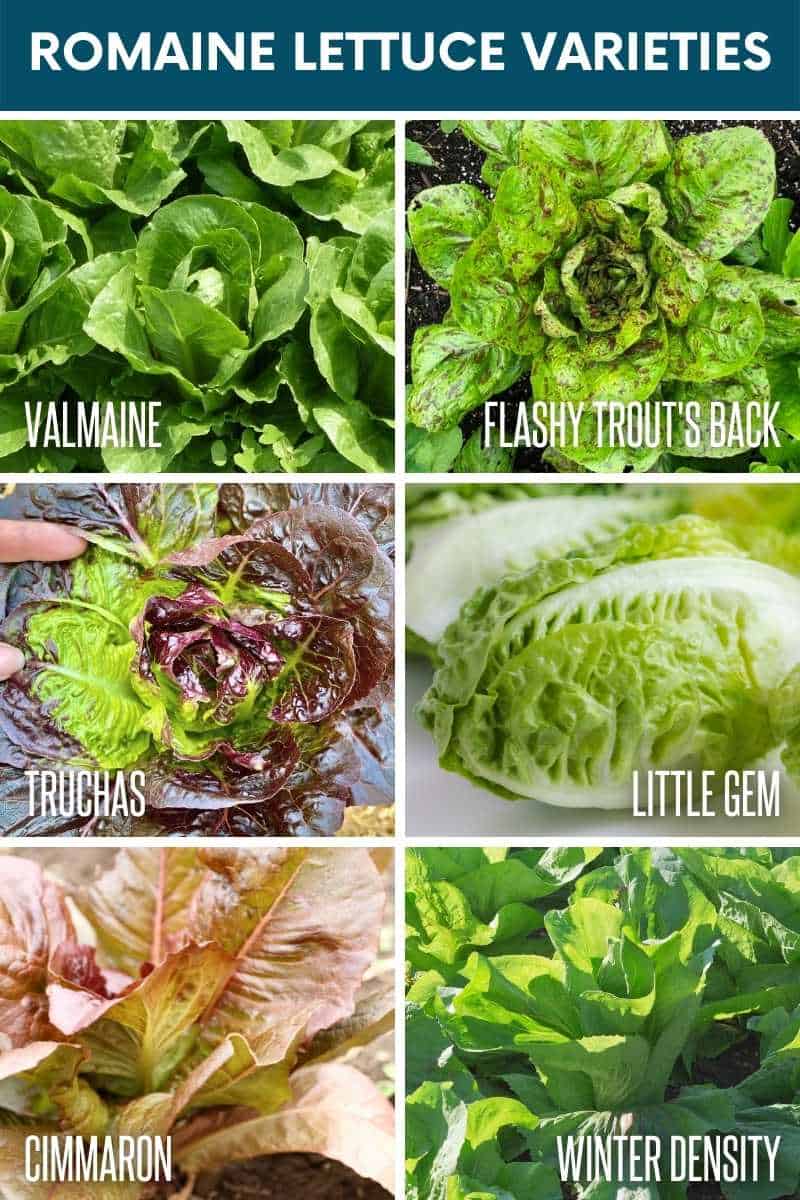
Should I grow romaine lettuce from seeds or plants?
Both are great options for growing romaine lettuce. Because lettuce plants produce relatively quickly, you can direct sow the seeds and still have plenty of time to harvest from each plant more than once. But if you want fresh veggies earlier in the spring, starting some seedlings indoors can give you a head start so you’re well on your way to crisp spring salads.
Growfully Protip
We tend to do both. We start a handful of lettuce plants from seed in late-winter, but then also direct sow lettuce seeds as soon as the soil can be worked. This gives us a nice succession of lettuce all season long.
When should I plant lettuce?
Lettuce can handle cooler soil temperatures than many other vegetables. Direct sow seeds or set out transplants 4-6 weeks before the last frost. If you’d like to start seeds indoors for an earlier harvest, start them 8-12 weeks before the last frost.
In milder climates, you can sow lettuce again in the late summer for a fall harvest. Direct sow lettuce seeds 6-8 weeks before your first frost in the fall. Depending on your climate, you might need to protect the young lettuce seedlings from the punishing heat of late summer. You can do this with shade fabric or by planting the lettuce seedlings around the base of a tall plant (like your tomatoes).
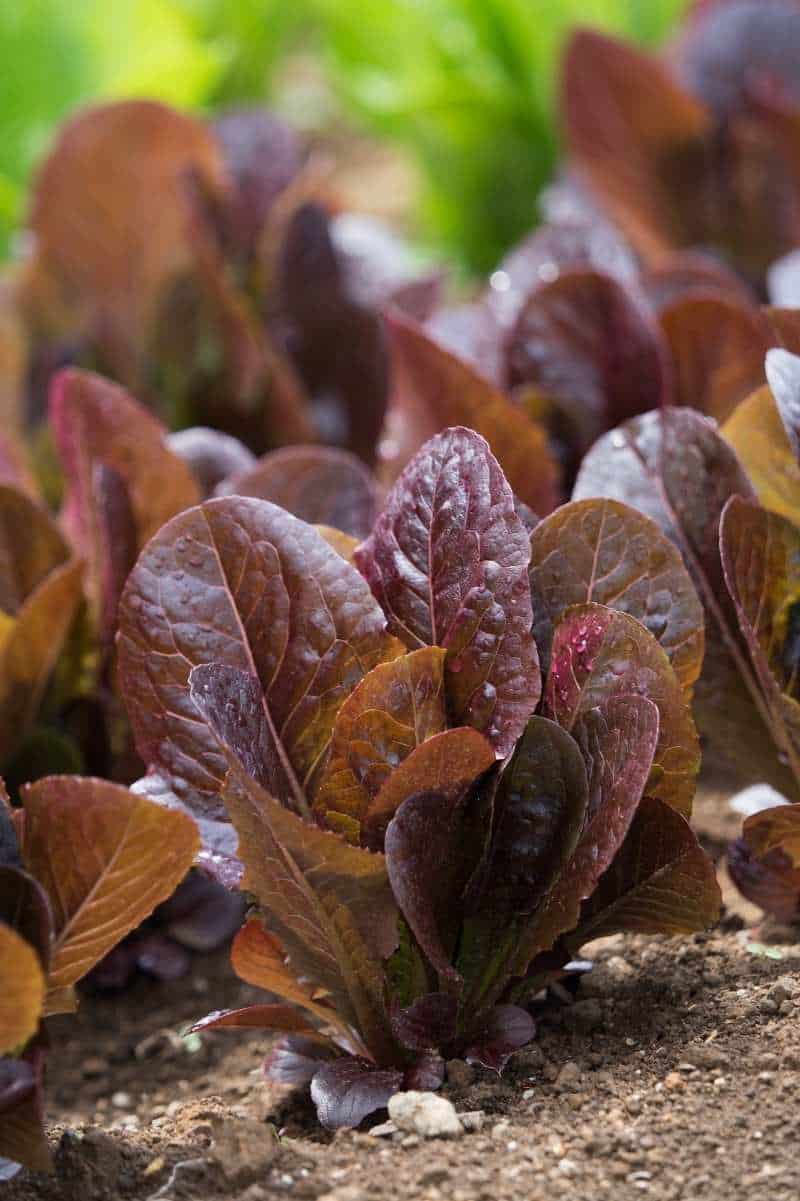
How long does it take to grow romaine lettuce?
Most romaine lettuce varieties will be ready to harvest as full heads within 50-75 days. You can start harvesting leaves from the outside of the plants within 30 days or so.
How do I direct sow lettuce?
Like most vegetables, romaine lettuce plants enjoy loose, rich soil with good drainage.
- Amend the soil with compost before planting.
- Sow seeds on top of the soil, lightly tamp down, and just barely cover with a dusting of soil. Lettuce seeds need light to germinate, so you don’t want to cover them too much. Romaine lettuce needs a bit more spacing to grow the large heads, so we recommend sowing 2-3 seeds every 9-12 inches (depending on the size of romaine variety you are growing).
- Water carefully (the mister setting on an adjustable hose nozzle is perfect for this), and keep the top of the soil damp until germination.
- Once seedlings have grown to about 1″ in height, thin the plants to one lettuce plant for every 9-11 inches.
Succession Planting
Sow more romaine lettuce seeds every two weeks in the spring and early summer to have continuous lettuce harvests.
Growfully Protip
We recommend starting your lettuce succession planting with cold-hardy varieties. As you get closer to warmer weather, start sowing varieties that are heat-tolerant and bolt-resistant.

How do I start and transplant lettuce seedlings?
- Fill a cell with sterile seed starting mix.
- Sow 2-3 seeds on the surface of the starting medium, and lightly tamp down.
- Gently water with a mister or spray bottle. Keep the top of the seed starting mix evenly moist until germination. Place the seeds in a warm area to germinate. You should see some seeds popping up within 5 to 7 days.
- Once seedlings are about an inch tall, clip any extra seedlings in each spot with a small pair of scissors.
- Seedlings can be planted out 4-6 weeks before the last frost date. Harden off the seedlings, and amend the garden soil with compost.
- Dig a hole that is slightly larger than the seedling pot.
- Place the seedling in the hole, and backfill with soil, using your hands to tamp down the soil around the plant.
- Give the romaine seedlings 9 to 12 inches spacing between plants.
How can I help my growing romaine lettuce plants thrive?
Lettuce plants are fairly low-maintenance once they are in the ground. Eventually, the plants will bolt—it’s just the nature of growing romaine lettuce! Here’s how we care for our lettuce plants and delay bolting as much as possible:
- Lettuce plants need about an inch of water a week. Do not allow the soil to dry out entirely and crust over, as this will stress the plants and give you bitter lettuce.
- If the leaves are wilting on hot days, give lettuce plants a drink of water to cool them down and perk them back up.
- Apply a thick layer of mulch around your romaine lettuce plants to keep the soil moist and cool. This will also help with weed management. We use pine shavings as our mulch of choice, but any organic mulch will work.
- Fertilize with a balanced fertilizer. We use a blend of fish emulsion and kelp, and apply every other week. Be careful not to use a fertilizer that is too heavy on the nitrogen, or it may turn the leaves bitter.
- In the heat of summer, lettuce plants enjoy partial shade during the hottest part of the day. You can achieve this by planting lettuce with larger plants that will shade them in the afternoon, using shade cloth floating row covers, or planting near a fence or tree that will cast an afternoon shadow.
- Lettuce plants have relatively shallow roots, so remove weeds by cutting them at the soil level rather than pulling them out.
What can I plant near my romaine lettuce?
One way to prolong the lettuce season in your garden is to interplant romaine lettuce with tall plants like tomatoes or sunflowers, which will provide some much-appreciated afternoon shade to the lettuce.
Alliums such as onions and garlic are also good companions for lettuce. The strong scent of the onions will repel pests.
Other good lettuce companions include:
- Broccoli and cauliflower
- Carrots
- Cucumbers
- Dill
- Spinach
- Squash
- Strawberries
- Tomatoes
- Strongly scented herbs such as basil and thyme

Do I need to rotate my crop?
While crop rotation can be an important part of organic gardening, it is less vital for lettuce than it is for plants like tomatoes or brassicas. If your lettuce has had a heavy pest infestation or serious disease, you’ll want to plant it in a different spot next year. Otherwise, don’t worry about it, and just fit lettuce into your garden plans wherever it fits best!
Can I grow romaine in containers?
Absolutely! All types of lettuce are suitable for container growing, thanks to their compact size and quick growing season. Just remember that the soil in containers will dry out much faster than the soil in raised beds or in-ground gardens, so you’ll need to water more often. A self-watering pot will keep the soil consistently moist, or you can just plan on watering your container lettuce more often. Make sure that whatever container you choose has drainage holes so that the roots aren’t sitting in water.
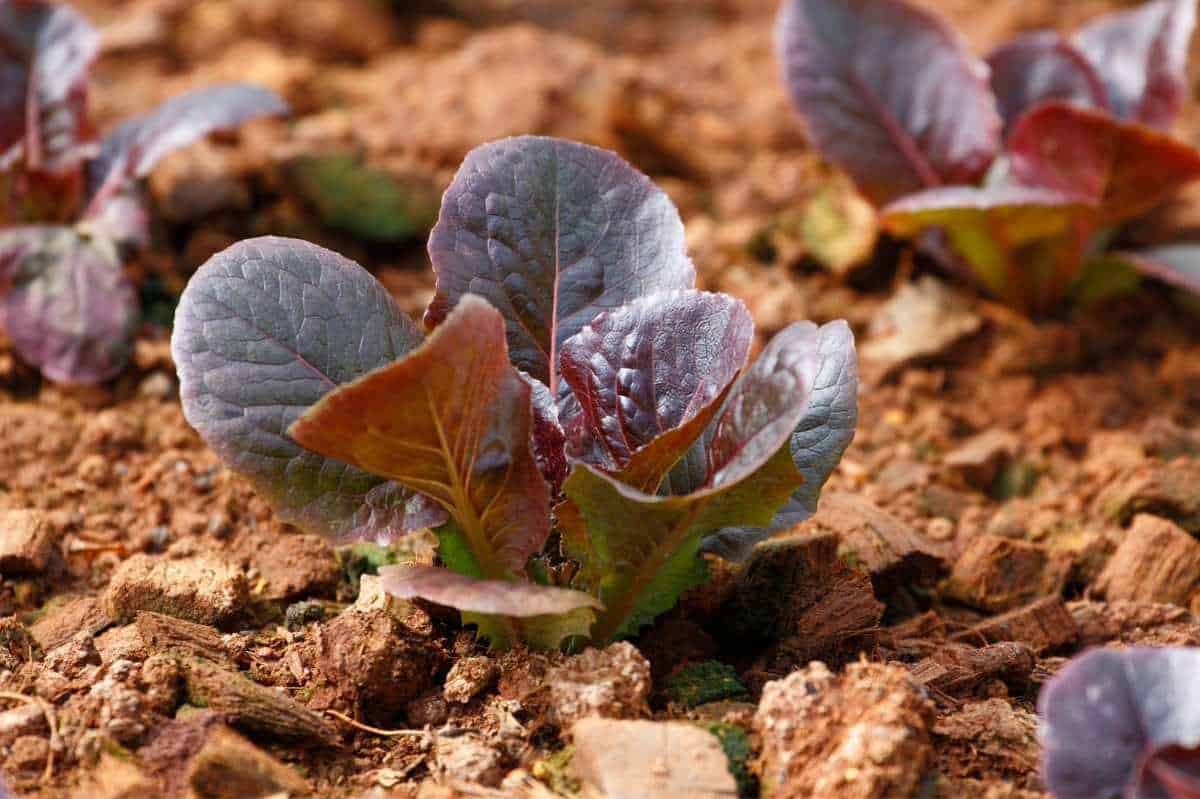
Can I grow romaine lettuce indoors?
You can, but you’ll likely have more success with leaf lettuce instead of heading lettuce like romaine. Lettuce can be grown indoors in a sunny spot (or with supplemental grow lights), away from drafts and hot spots.
How do you harvest romaine lettuce?
Harvest romaine lettuce in the evening or early morning to keep the leaves crisp and unwilted. Using a sharp knife or scissors, cut off individual leaves or the entire head of lettuce at the base. If you choose to harvest the entire head, leave about an inch of the plant in the ground so that the lettuce can regrow.
Wrap your romaine in a damp dishtowel and refrigerate it in an airtight container to keep it fresh and crisp. You can also store the lettuce in VejiBags to keep the leaves fresh for 10-14 days.
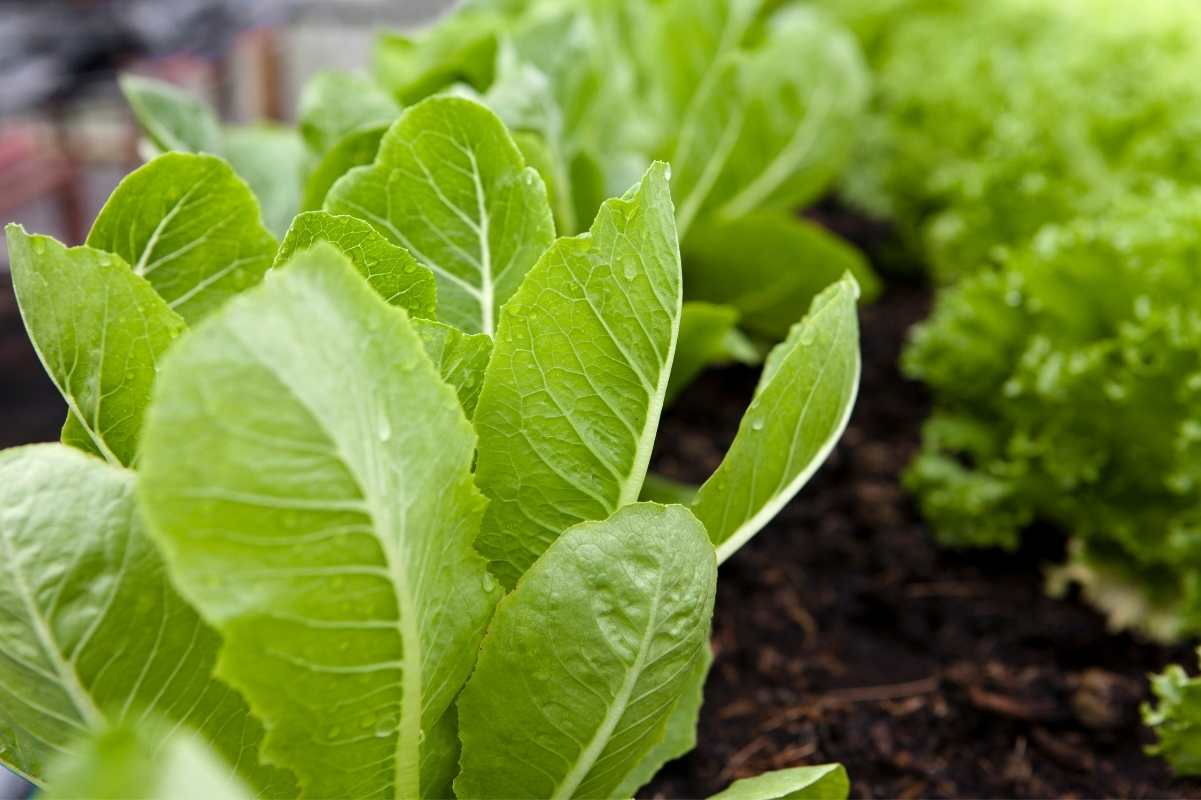
Can you cut and come again romaine lettuce?
Yes! If you leave around an inch of the plant sticking out of the ground when you harvest, a new head will start to grow. In most climates, you can do this 2 to 3 times before the plant finally taps out for the season.
Growfully Protip
We tend to prefer harvesting individual leaves from romaine plants over harvesting entire heads. You can cut off or snap off the outside leaves of a romaine plant and get plenty of leaves for a side salad!

Troubleshooting
Why is my romaine bitter?
There are two main causes of bitter lettuce. The most common cause is plant stress. Heat prompts lettuce to bolt and flower, which turns the leaves bitter. Underwatering or inconsistent watering can make for bitter lettuce as well, so keep the soil consistently moist (but not soggy!).
The second cause of bitter lettuce is over-fertilization with nitrogen. We recommend feeding your lettuce plants with a balanced, low-intensity fertilizer (we like diluted liquid fish emulsion and kelp).
Pests
- Slugs and snails especially enjoy munching on lettuce. If you spot irregularly-shaped holes on the lettuce leaves, you may have slugs or snails. There are lots of ways to repel and deal with slugs organically, from physical barriers to manual removal to grapefruit traps.
- Aphids may enjoy munching on succulent lettuce leaves as well. They can be removed manually or with a natural bug repellent. If there are still aphids on your romaine lettuce after harvest, swish the lettuce in a large bowl of water with a drop of soap to remove them. Wash thoroughly with just water before serving.
- Cutworms are the most active in early spring when lettuce is one of the only fresh veggies growing in the garden. They can make quick work out of destroying a lettuce plant because they chew through the base of the plant. Prevention is the best treatment for cutworms—make your garden welcoming to birds and beneficial insects and remove garden debris that they might overwinter in at the end of the season. You can also place a barrier around the outside of your lettuce plant after transplanting— a small ring cut from a paper towel roll works. Cutworms don’t tend to be a problem once the plant has established itself.
- Rabbits, deer, and other critters love to munch on fresh lettuce. Fencing is the best way to keep these animals away from your romaine plants, though you can also try interplanting lettuce with strongly-scented vegetables and herbs to deter them.

Growing Romaine Lettuce
Fresh romaine lettuce is a tasty, crunchy vegetable that also happens to be very easy to grow. Follow this guide to learn about growing Romaine lettuce.
Materials
- Lettuce seeds
Tools
- Rich soil
- Sunny spot with afternoon shade
Instructions
- Keep the soil moist. If the soil dries out entirely and crusts over, the plants will be stressed and may become bitter.
- Use mulch. Mulch will help the soil stay cool and moist, and will also suppress weeds.
- Use a balanced fertilizer. Nitrogen-rich fertilizers will turn lettuce leaves bitter, so use a balanced fertilizer. We like a blend of fish emulsion and liquid kelp.
- Weed carefully. Use a sharp pair of garden scissors to weed around lettuce rather than yanking out the weeds. This will protect lettuce's fragile roots.
- Provide afternoon shade. To delay bolting, protect lettuce from the hottest part of the day by providing some light afternoon shade. This can be achieved by planting lettuce around tall plants, using shade cloth, or planting near a fence or tree that will cast a shadow in the afternoon.

